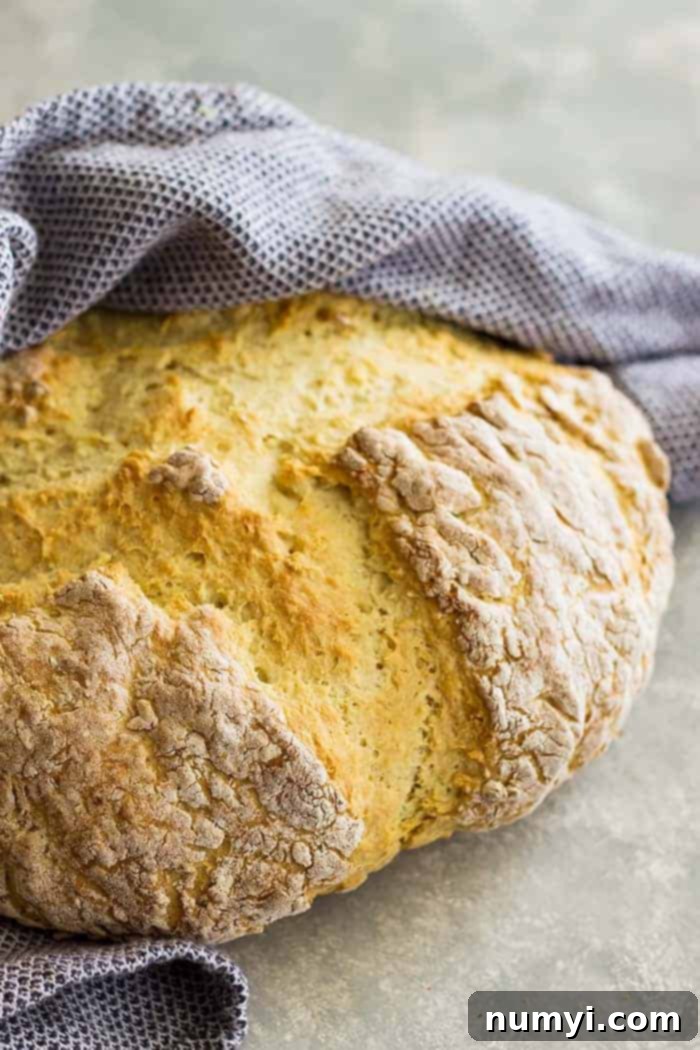Traditional Irish Soda Bread: An Easy 4-Ingredient, No-Yeast Recipe for Every Occasion
Imagine a warm, rustic loaf of bread, with a perfectly craggy crust and a soft, dense interior, ready in under an hour without any fuss. This isn’t a dream – it’s the magic of **Traditional Irish Soda Bread**. Forget waiting for yeast to rise; this incredibly simple recipe relies on just four pantry staples and a quick bake, making it the ultimate homemade bread for beginners and seasoned bakers alike. Whether you’re celebrating St. Patrick’s Day, looking for a comforting side for your stew, or simply craving a delicious, rustic loaf, this easy Irish soda bread recipe is about to become your new favorite. Its no-yeast, 4-ingredient approach truly simplifies baking, bringing an authentic taste of Ireland straight to your kitchen.
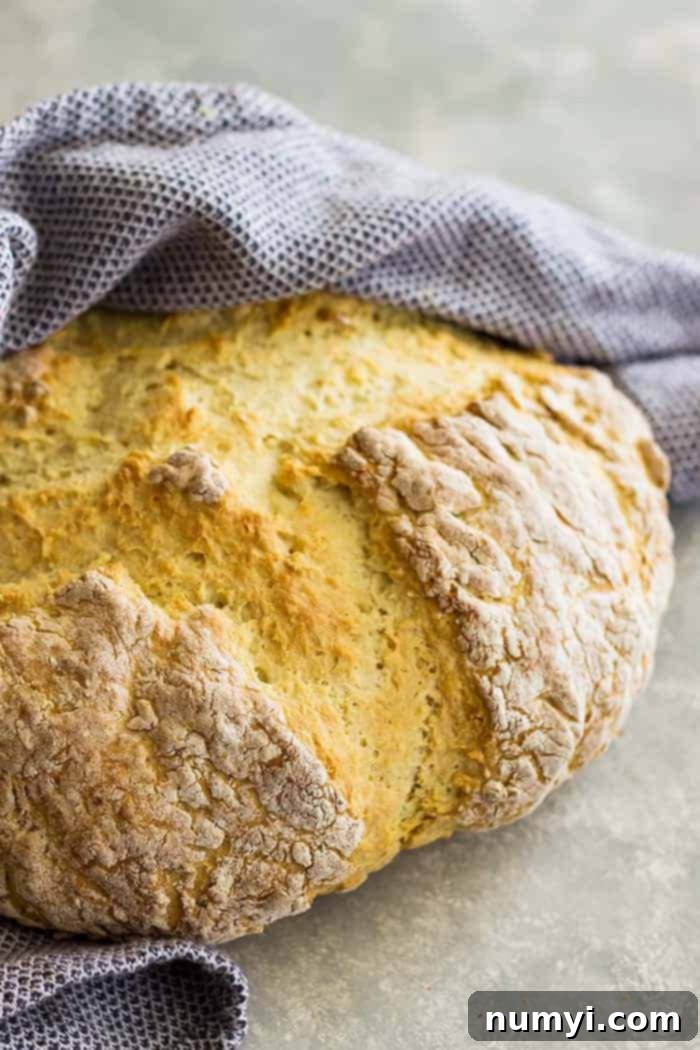
Many people associate Irish Soda Bread exclusively with St. Patrick’s Day. While it’s certainly a festive and appropriate addition to any celebration of Irish culture, this versatile loaf deserves a place on your table all year round. Its dense, moist, and subtly tangy flavor profile makes it an ideal accompaniment to hearty soups, stews, and roasts, or simply enjoyed warm with a generous smear of butter and jam. Once you discover how truly easy and satisfying it is to bake this no-yeast bread, you’ll find countless excuses to make it time and time again. It’s quick, it’s comforting, and it’s authentically delicious.
If you love simple, satisfying bread recipes that don’t require extensive effort, you might also enjoy these other quick and easy options. They’re perfect for expanding your baking repertoire: Beer Bread (a flavorful loaf that pairs wonderfully with savory meals and comes together with minimal fuss), Buttermilk Cornbread (my personal favorite for a sweet and savory balance, and another excellent quick bread), and Garlic Cheddar Biscuits (a family staple we whip up frequently for breakfast or as a side, offering rich flavors in a fluffy package).
Why You’ll Adore This Easy Irish Soda Bread with Buttermilk
This Traditional Irish Soda Bread recipe is more than just a culinary tradition; it’s a testament to simple, delicious baking. Here are the compelling reasons why this particular buttermilk soda bread will quickly become a cherished recipe in your home:
- Unbelievably Simple Ingredients: You literally only need four basic items from your pantry – flour, tangy buttermilk, active baking soda, and a touch of salt. No obscure spices or specialty flours are required, making it accessible to everyone.
- No Yeast, No Wait: One of the biggest advantages of this no-yeast bread is that there’s no proofing or rising time involved. This cuts down significantly on the total preparation, allowing you to have fresh, homemade bread on the table in a fraction of the time compared to traditional yeast breads.
- Less Than an Hour to Deliciousness: From the moment you start mixing until you pull a golden-brown loaf from the oven, the entire process takes less than 60 minutes. It’s the perfect solution for last-minute meal additions or sudden bread cravings.
- A Crowd-Pleasing Delight: Its rustic charm and authentic, comforting flavor make it a fantastic centerpiece for any gathering. Whether it’s a casual family dinner, a festive holiday meal, or a themed St. Patrick’s Day party, this bread is sure to impress.
- Deeply Satisfying Flavor and Texture: You’ll love the dense, yet tender crumb, the subtle tang from the buttermilk, and the wonderfully crusty exterior. Each slice offers a satisfying chew and a rich, wholesome taste that complements a wide array of dishes.
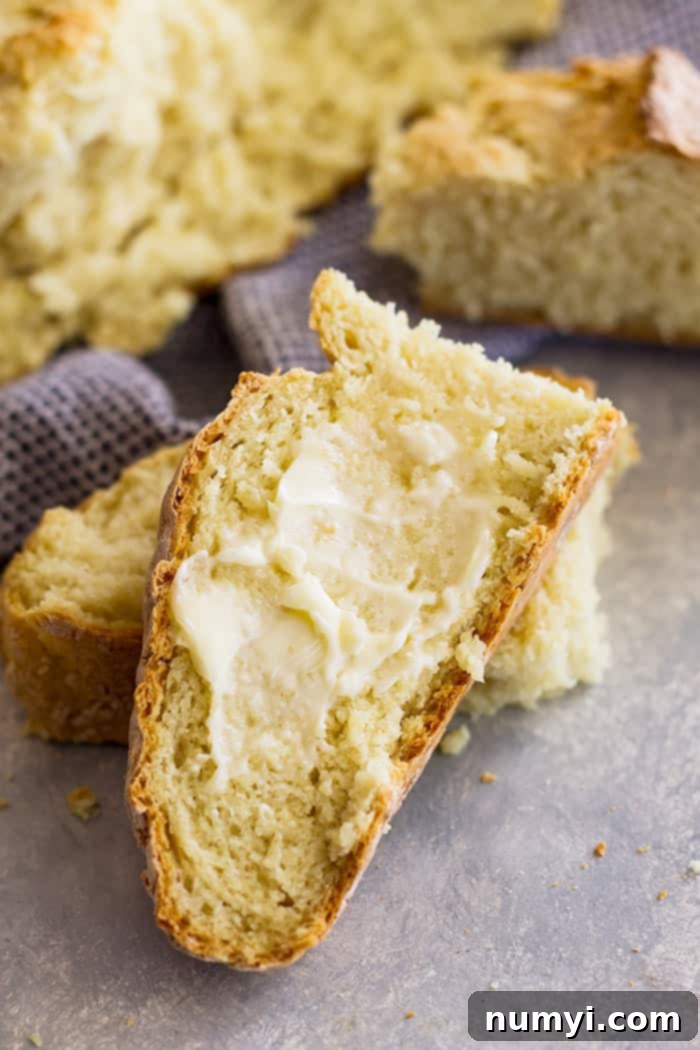
A Rich History: The Story of Authentic Irish Soda Bread
Beyond its delicious taste, Irish Soda Bread carries a fascinating history, deeply rooted in Irish culture and practicality. Understanding its origins adds another layer of appreciation to each bite of this rustic loaf. Born out of necessity, it became a cornerstone of Irish culinary tradition. Here are a few intriguing facts about this beloved bread that highlight its cultural significance:
- The Protective Cross: Before baking, a distinctive cross is traditionally slashed into the top of the dough. While some folklore suggests this was done to “let the fairies out” or to ward off evil and **protect the household** from malevolent spirits, it also serves a very practical purpose in baking. This cut helps the dense center of the bread cook thoroughly and evenly, ensuring a consistent texture throughout the loaf. Skipping this simple yet crucial step can result in an undercooked middle!
- A Culinary Staple During Hard Times: During the mid-1800s, particularly in the shadow of the Great Famine and other periods of hardship, soda bread became an incredibly important and affordable food source in Ireland. It was so widely consumed as a daily bread that baking soda, a relatively new ingredient at the time, saw its price nearly double due to overwhelming demand! It was an **inexpensive and efficient way to provide sustenance** for families, often baked fresh daily on open hearths or in bastible pots.
- Simplicity is Key to Authenticity: True authentic Irish soda bread is famously minimalist. It should only ever contain these **four core ingredients**: soft wheat flour (typically the less strong varieties grown in Ireland), tangy buttermilk, a pinch of salt, and, of course, baking soda. Any additions like raisins, caraway seeds, or sugar, while delicious and common in modern variations, technically move it away from the traditional, rustic Irish farmhouse loaf.
- Regional Flour Variations: While the basic recipe is simple, there were regional differences in Ireland based on local flour availability. In the south, a softer wheat flour was more common, resulting in a lighter bread, often cooked on a griddle as “farls.” In the north, harder flours yielded a denser loaf, typically baked in a bastible pot over a fire, or later, in peat-fired ovens.
The Four Simple Ingredients for Your Best Irish Soda Bread
The enduring appeal of authentic Irish Soda Bread lies in its elegant simplicity. With just four humble ingredients, you can create a truly remarkable loaf that captures the essence of Irish home baking. Each component plays an absolutely crucial role in achieving the characteristic texture and flavor of this classic quick bread:
- Buttermilk: This is unequivocally the star ingredient, providing both essential moisture and the signature tangy flavor that defines Irish Soda Bread. More importantly, buttermilk’s acidity reacts chemically with the baking soda to create carbon dioxide gas, which acts as the sole leavening agent for this yeast-free bread, making it rise. For the richest flavor and best texture, I highly recommend using whole buttermilk, but 2% buttermilk will also yield excellent results. I strongly advise against using anything lighter than 2% milk if possible, as the fat content significantly contributes to the bread’s desired moistness and tender crumb. If you find yourself without store-bought buttermilk, don’t fret! You can easily **make your own buttermilk substitute**: simply pour 2 tablespoons of white vinegar or fresh lemon juice (ensure it’s fresh, not bottled concentrate) into a liquid measuring cup. Then, fill the rest of the way to the 2-cup line with whole milk or 2% milk. Let this mixture stand undisturbed for 5-10 minutes until it slightly curdles and thickens, then use it as directed in the recipe.
- Baking Soda: As the name “soda bread” suggests, baking soda is the critical leavening agent that allows this bread to rise beautifully without any yeast. Its magic happens when it reacts with the acid in the buttermilk, producing tiny carbon dioxide bubbles that expand during baking, giving the bread its characteristic lift and texture. For optimal results, always ensure your baking soda is fresh – you can test its potency by adding a small amount to a bit of vinegar; if it fizzes vigorously, it’s good to go!
- Salt: Often overlooked but incredibly important, salt is a crucial flavor enhancer in this recipe. It balances the natural tanginess of the buttermilk and brings out the subtle, wholesome flavors of the flour. Do not omit the salt, as it significantly impacts the overall depth and enjoyment of your loaf.
- Flour: Traditionally, a softer white wheat flour was used in Ireland, which contributes to the characteristic tender crumb of soda bread. For this recipe, readily available all-purpose flour works perfectly and will give you an excellent result. While some modern recipes might suggest bread flour, sticking to all-purpose or even a pastry flour will generally give you a texture closer to the authentic, rustic Irish preparation. Avoid strong bread flours as they can lead to a tougher loaf due to higher gluten development.
These four simple yet powerful ingredients combine harmoniously to create an authentic Irish Soda Bread that boasts a dense yet tender crumb, a subtly sour note derived from the buttermilk, and a wonderfully hard, rustic crust. The resulting texture and flavor are often delightfully compared to a hearty buttermilk biscuit or a savory scone, making it incredibly versatile for various culinary applications. It’s truly perfect to pair with robust, warming dishes like thick soups and hearty stews, but it’s equally delightful served warm on its own, generously slathered with softened butter or your favorite homemade jam for a simple, comforting treat.
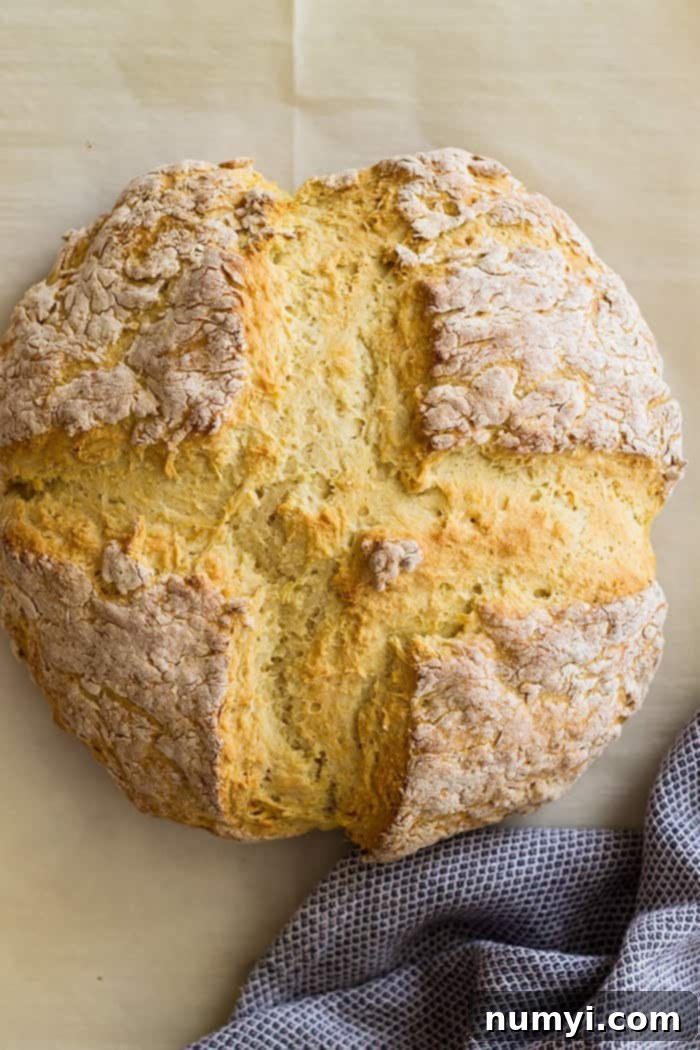
Baking Your Traditional Irish Soda Bread: Expert Tips for Success
While this recipe is celebrated for its straightforwardness, a few key tips and techniques can help you achieve the perfect loaf of Traditional Irish Soda Bread every single time. The core philosophy here is to handle the dough minimally to ensure a tender crumb and a beautiful, rustic crust.
Mixing and Kneading: Less is Truly More
When you’re combining your dry ingredients with the buttermilk, do so gently and with a light hand. Stir just until the mixture comes together and becomes too stiff to stir comfortably with a spoon or spatula. The moment you see the dry flour disappear and the dough form a shaggy mass, stop mixing. Overmixing is the enemy of tender soda bread, as it excessively develops the gluten in the flour, which can lead to a tough and chewy loaf. Once transferred to a lightly floured work surface, a very light kneading of just 5-10 times is all that’s truly needed – just enough to fully moisten any remaining flour and coax the dough into a cohesive, albeit slightly sticky, ball. Remember, a slightly sticky and “shaggy” dough is perfectly normal and desired for this type of bread!
The All-Important Cross Slash
As we’ve explored in its rich history, the cross etched into the top of the dough isn’t just a nod to tradition; it’s profoundly functional. A deep slash – specifically about ¼ to ½ inch deep – serves a critical purpose during baking: it allows the intense heat of the oven to penetrate more effectively into the center of the dense dough. This ensures that the bread bakes through evenly from edge to center, preventing a raw or gummy middle. Don’t be shy or tentative with your sharp knife when making this cut!
Achieving the Perfect Golden Crust and Doneness
Baking your Irish Soda Bread at a slightly higher temperature, specifically 400°F (200°C), plays a crucial role in creating that wonderfully desirable hard, golden-brown crust while simultaneously locking in the moisture, keeping the inside tender. You’ll know your bread is perfectly done when it boasts a beautiful golden-brown color and, when gently tapped on the bottom, it produces a hollow sound. For those who prefer precision, an instant-read thermometer inserted into the very center of the loaf should register an internal temperature of 195°F (90°C).
FAQs About Traditional Irish Soda Bread
Got questions about this rustic, no-yeast bread? Here are some common queries and their answers to help you master your Irish Soda Bread baking and enjoy every delicious bite.
Absolutely! While adding extra ingredients will, by definition, make it less “traditional” in the strictest, minimalist sense, it’s a fantastic and popular way to customize your loaf and explore new, delicious flavor combinations. Many people enjoy incorporating a touch of sweetness, extra texture, or additional savory notes. Here are some popular ideas to get you started on customizing your homemade soda bread:
- Dried Fruits: For a subtly sweet and chewy texture, mix in ½ to 1 cup of raisins, currants, or dried cranberries. For an even plumper, juicier result, you can soak the dried fruit briefly in warm water or even a splash of tea before gently folding them into the dough.
- Citrus Zest: Add 1-2 teaspoons of finely grated orange zest or lemon zest for a bright, aromatic, and refreshing flavor that beautifully complements the tang of the buttermilk.
- A Hint of Sweetness: If you prefer a slightly sweeter loaf, you can easily incorporate 1-2 tablespoons of granulated sugar, brown sugar, or even a modest drizzle of honey or maple syrup into the dry ingredients before adding the buttermilk.
- Caraway Seeds: For a more savory and distinctly aromatic twist, a tablespoon of caraway seeds is a classic addition in some regional Irish soda bread variations, offering a unique, earthy flavor.
- Savory Additions: For a truly savory loaf, consider folding in a quarter to a half cup of chopped fresh herbs like rosemary or chives, along with a half cup of grated sharp cheddar or a firm Irish cheese.
To ensure your Irish Soda Bread remains as fresh and delicious as possible, proper storage is key. For the best quality and to prevent sogginess, always allow the freshly baked loaf to cool completely on a wire rack before attempting to store it. Once it has reached room temperature, wrap the entire loaf securely in plastic wrap or aluminum foil. Then, place the wrapped bread in an airtight container or a large resealable freezer bag. Stored this way, your homemade Irish Soda Bread will remain fresh and flavorful at room temperature for up to 4 days. While it’s truly at its peak when enjoyed on the day it’s baked, slices of day-old soda bread make for absolutely excellent toast!
Yes, absolutely! Irish Soda Bread freezes wonderfully, making it a fantastic option for meal prep or ensuring you always have a comforting, homemade loaf on hand whenever a craving strikes. To freeze effectively, ensure the bread is completely cool after baking. Then, wrap it meticulously: first, wrap it tightly in plastic wrap, followed by a sturdy layer of aluminum foil, or place it directly into a heavy-duty freezer bag, making sure to squeeze out as much air as possible to prevent freezer burn. Properly stored, it can be frozen for up to 3 months without significant loss of quality. When you’re ready to enjoy it, simply thaw the bread overnight at room temperature. For an extra touch of freshness, you can then gently warm it in a low oven (around 300°F/150°C) for 10-15 minutes to refresh the crust and revive its tender interior.
For achieving the most authentic Traditional Irish Soda Bread, a softer flour is generally preferred, as it contributes to the bread’s characteristic tender crumb. Widely available all-purpose flour (also known as plain flour in some regions) works absolutely perfectly for this recipe and will yield a delicious result. If you happen to have access to a soft white wheat flour or pastry flour, those would also be excellent choices as they naturally have a lower protein content, which is ideal for minimizing gluten development. Avoid using strong bread flours, as their higher protein content can make your soda bread tougher and chewier than desired.
If your homemade Irish Soda Bread turns out dry, dense, or excessively crumbly, it’s most commonly due to one of two primary reasons: overmixing the dough or overbaking the loaf. Overmixing is a frequent culprit, as it overdevelops the gluten in the flour, which leads to a tough, dry, and sometimes rubbery texture. Remember the “less is more” rule and mix only until the ingredients are just combined. Overbaking can also severely dry out the loaf by evaporating too much moisture, so keep a close eye on your bread during the final stages of baking. Remove it from the oven once it’s beautifully golden brown and sounds hollow when tapped, or when an instant-read thermometer registers 195°F (90°C) internally. Additionally, ensuring you use whole buttermilk (or at least 2%) significantly contributes to a moist and tender loaf.
Delicious Ways to Serve This Traditional Irish Soda Bread
The versatility of Traditional Irish Soda Bread is undeniably one of its most appealing qualities. Its robust flavor and satisfying texture make it suitable for a wide range of meals, from simple breakfasts to hearty dinners, and for countless occasions. Here are some of our absolute favorite ways to enjoy a freshly baked loaf, ensuring you make the most of its rustic charm:
- Classic Comfort: The simplest and often best way to enjoy it is served warm, straight from the oven. Break off a piece and slather it with generous pats of unsalted butter, allowing it to melt into the dense, warm crumb for an unforgettable experience.
- Breakfast or Brunch Delight: Reheat slices slightly or toast them for breakfast or brunch. They are magnificent when topped with your favorite fruit jam, marmalade, or a drizzle of local honey. For a more substantial start to your day, try it with a perfectly poached or fried egg nestled on top.
- The Perfect Companion for Savory Meals: Its substantial, denser texture and thick, crusty exterior make it an incredibly ideal companion for a variety of savory, comforting dishes. It pairs beautifully with hearty soups, such as a rich potato leek soup, a creamy mushroom soup, or a robust beef and vegetable stew. It’s also an essential side for traditional Irish fare like corned beef and cabbage, or any Sunday roast.
- Elevate Your Cheese Board: Slice it thinly and arrange it alongside a curated selection of your favorite cheeses, some savory charcuterie, and sweet or tangy chutneys for a rustic yet elegant appetizer or a delightful snack. Its sturdy nature holds up well to various toppings.
- Homemade Open-Faced Sandwiches: While denser than typical sandwich bread, slices of warm or toasted soda bread can serve as a uniquely delicious base for open-faced sandwiches. Top with smoked salmon and cream cheese, or perhaps some sliced avocado and a sprinkle of sea salt.
HUNGRY FOR MORE? Don’t miss out on more delicious recipes, expert baking tips, and culinary inspiration! Subscribe to my newsletter and follow along on Pinterest, Facebook, and Instagram for all my latest updates and delightful culinary adventures!
Traditional Irish Soda Bread
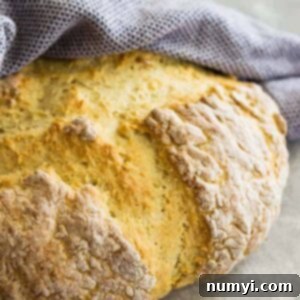
Ingredients
- 4 cups (580g) all-purpose flour
- 1½ teaspoons baking soda
- 1 teaspoon salt
- 2 cups (470ml) cold buttermilk
Instructions
-
Preheat oven to 400℉ (200°C). Prepare your baking surface by lining a baking sheet with parchment paper or greasing it well; set aside. As an alternative, you can also use an 8-inch cast iron skillet or a cake pan for baking.
-
In a large mixing bowl, thoroughly whisk together the all-purpose flour, baking soda, and salt until they are well combined. Gradually pour in the cold buttermilk, stirring with a wooden spoon or spatula just until the dry ingredients are moistened and the dough starts to become too stiff to stir easily. Be careful not to overmix at this stage.
-
Transfer the shaggy dough to a lightly floured work surface. With floured hands, gently knead the dough only 5-10 times. The goal is just to incorporate any remaining loose flour and bring the dough together into a cohesive, slightly sticky ball. Avoid excessive kneading to keep the bread tender.
-
Form the dough into an 8-inch round loaf. Carefully place it on your prepared baking sheet or into the chosen pan. Using a very sharp knife, cut a deep cross (approximately ¼ to ½ inch deep) into the top of the loaf. This crucial step helps the bread bake evenly and allows steam to escape.
-
Bake for 45-50 minutes, or until the crust is beautifully golden brown and the loaf sounds hollow when tapped on the bottom. For a precise measure of doneness, an instant-read thermometer inserted into the center of the loaf should read 195℉ (90°C). Once baked, transfer the bread to a wire rack and let it cool for at least 10-15 minutes before slicing and serving.
Notes
- This Traditional Irish Soda Bread is at its absolute best when served warm, shortly after baking, as the crust is at its crispiest and the interior is most tender. However, any leftovers can be stored at room temperature, tightly wrapped in plastic wrap or foil, for 2-3 days. For longer preservation, this bread freezes beautifully for up to 2-3 months.
- Buttermilk is an essential ingredient for both the authentic flavor and characteristic texture of this recipe. It cannot be simply replaced with plain milk. If you don’t have store-bought buttermilk on hand, you can easily create a workable substitute: simply pour 2 tablespoons of white vinegar or fresh (not bottled) lemon juice into a liquid measuring cup. Then, fill the remainder of the cup to the 2-cup line with whole milk or 2% milk. (I don’t recommend using anything less than 2% for this recipe to ensure optimal richness and moisture.) Let this mixture stand for 5-10 minutes until it slightly curdles and thickens before using it in your recipe.
- Nutrition Facts: Please note that nutritional information provided is an estimate only. The exact values can vary based on specific brands of ingredients used and any modifications made to the recipe. This information is calculated for the entire loaf.
Nutrition
